Click image for BBB rating
See our Privacy Policy
cool="cool" width="833" height="19465" border="0" cellpadding="0" cellspacing="0" gridx="16" showgridx="showgridx" usegridx="usegridx" gridy="16" showgridy="showgridy" usegridy="usegridy" bgcolor="#99ccff">
|
 |
|
|
|
|
|
|
|
Welcome to Spaightwood Galleries, Inc.
For more information or to purchase, please call 1-800-809-3343 or email us at
|
|
|
|
In his chapter in Pietro Perugino: Master of the Italian Renaissance, ed. Joseph Antennucci Becherer (Grand Rapids MI Art Museum, 1997), Bruce Cole argues that "Renaissance artists were made, not born. . . . Boys entered a workshop with no experience and came out of it as artists with remarkable technical and formal skills, among the most advanced of any period of European art" (p. 26). In addition to learning how to make brushes, grind pigments, lay plaster for frescoes, prepare gesso, and the like" (p. 27), they were to learn to draw by "strict imitation of style and motif. Apprentices were to copy the work of their master until his style became their own. They were also encouraged to learn from the paintings and drawings of other masters. These works could furnish them with many types of compositions and motifs which would be of considerable benefit to them later on" (p. 27). Vasari's "Life" of Raphael suggests that even a gifted individual could profit from this system: "It is well known that while Raphael was studying Pietro's style he imitated him so exactly in everything that his portraits cannot be distinguished from those of his master" (Lives of the Painters, Sculptors and Architects, 4 vols., trans. A. B. Hinds (NY: Everyman's Library, 1963; 1970), II: 222). Needless to say, however, Raphael did not continue to turn out "Peruginos" after he left his master's workshop; rather, following this procedure during his career, he moved from model to model until he had established and refined his own style by his continuing explorations of other masters like Leonardo and Michelangelo. Raphael, in turn, presided over a large workshop with masters like Giulio Romano, Perino del Vaga, and others who while they worked for him could help him with the drawings that preceded the paintings of his works. When they in turn came to head their own workshops, they did not continue to turn out more "Raphaels" but instead produced "Giulios" and "Perinos."
If we compare the instructions Michelangelo wrote on a drawing he gave to one of his assistants, Antonio Mini (d. 1533), "Disegnia antonio, disegnia antonio / disegnia e no[n] p[er]der[e] te[m]po" (Draw Antonio, draw Antonio, draw and don't waste time" (Hugo Chapman, Michelangelo [New Haven, Yale University Press, 2006), drawing, figure 27, and detail, figure 28), with Cole's description of how workshops worked, it is clear that something has changed. The drawings were not for works to be realized—many of Michelangelo's later drawings seem to be intended for his own use or as gifts for his friends and were never intended to serve as models of paintings or sculptures—but as a way of thinking about images and their meanings, as opposed to their practical uses. These late drawings are perhaps part devotional, part opportunities for Michelangelo to think about the mechanics of transforming thoughts into images of ideas. According to William Wallace, Michelangelo: The Artist, the Man, and His Times (Cambridge: Cambridge University Press, 2010), Michelangelo's friendships with Tommaso de'Cavalieri led to "both a large body of poetry and some of Michelangelo's most beautiful drawings" and "reawakened in Michelangelo those highly focused creative energies that the artist commonly experienced at the beginning of projects" (Wallace, p. 177); the most important of the drawings were probably the Ganymede, the Tityus, The Fall of Phaeton, The Dream of Human Life, Three Labors of Hercules, the Children's Bacchanal, Archers Shooting at a Herm, and a Head in Profile (see Frederick Hartt, Michelangelo Drawings (NY: Abrams, n.d. [1970], figures 352-62). His later friendship with Vittoria Colonna, begun after The Last Judgment for the Sistine Chapel, led him to send her a series of drawings of the Crucifixion and other related pieces (see Hartt, figures 408-430 and possibly figure 437). Hartt's comment on the group for Tommaso Cavalieri is directly pertinent: "A considerable group of drawings by Michelangelo, generally of the highest finish, were done without the customary Renaissance purpose of preparation for works of painting or sculpture, but as complete works of art in themselves" (p. 249). With the example of Michelangelo as a precedent, there can be little doubt that other artists (Veronese and Guercino come quickly to mind) did the same.
Detaching the drawing from the painting or sculpture and looking at it as an independent work of art changes the way drawings might be seen. As Beth L. Holman observes, “Both prints and drawings provide important primary documents of Renaissance designs for objects of ritual and everyday life. In Italy, design–the foundation of art–and drawing–the cornerstone of design–were so intimately linked that they were embraced under the same rubric: disegno. As Federico Zuccaro wrote at the end of the sixteenth century, drawing is the external, physical manifestation [disegno esterno] of an internal, intellectual idea or design [disegno intorno]” (see her introduction to Disegno: Italian Renaissance Designs for the Decorative Arts [Washington DC: Cooper-Hewitt National Design Museum, Smithsonian Institution, 1997], p. 10). Michelangelo's liberation of the drawing from something mechanical to something capable of showing viewers truths opens up a new way of looking at drawings. As Holman notes, “The implications of disegno were both broad and profound. Ideation was considered to be paramount in the creation of art. Artists were praised for their invenzione [invention], ingegno [ingenuity], fantasia [imagination], and capriccio [originality]” (p. 11). The artist was no longer merely a craftsman but someone able (and perhaps obligated) to show his or her audience a new world. As Sir Philip Sidney wrote in his Defence of Poetry (c. 1579), "any understanding knoweth the skill of each artificer standeth in that idea or fore-conceit of the work and not in the work itself. And that the poet hath that idea is manifest, by delivering them forth in such excellency as he had imagined them" (ed. J. A. Van Dorsten [London: Oxford University Press, 1966], p. 24). So in the case of the Michelangelo drawings of the Crucifixion for Vittoria Colonna or the works for Tommaso de'Cavalieri it is not simply the execution that moved viewers but their attempts to seize an understanding of the reasons behind each particular embodiment of that idea at which viewers were astonished (sometimes literally: it is reported that when Pope Paul III first saw the The Last Judgment Michelangelo had painted for him, he sank down to his knees and prayed for several hours as if he were looking not at paint on a wall but seeing the event to come. This notion of "making" leads Sidney to take an old definition of poetry and to transform it via a kind of shot-gun marriage to another one: "Poesy therefore is an art of imitation, for so Aristotle termeth it in the word mimesis–that is to say, a representing, counterfeiting, or figuring forth–to speak metaphorically, a speaking picture–with this end, to teach and delight" (p. 25). True makers (and as poetry is a speaking picture, so painting is silent poetry) "imitate to teach and delight, and to imitate borrow nothing of what, hath been, or shall be; but range, only reined with learned discretion, into the divine consideration of what may be and what should be" (p. 26). Sidney, more than most Englishmen of the period, had a direct acquaintance with the art of his day. He had been to Venice and visited both Tintoretto and Veronese before deciding to have Veronese paint his portrait so that he could send it to a friend. Sidney, who was fluent in Italian, had also spent time with Federico Zuccaro when Zuccaro was in London discussing possible commissions with the Earl of Leicester, Sidney's uncle, and staying at Leicester House, where Sidney also stayed when he was in London, as he was at that time.
As former teachers of Renaissance literature, we found ourselves drawn to the prints and drawings of the period. This interest (tending at times to obsession), prompted our acquisition of a number of old master drawings, including works by Netherlandish artists like Bernaert van Orley, Maarten de Vos, Jan Baptiste de Wael, Willem Buytewech, Abraham Bloemaert, Peter Paul Rubens, Philipp Sadeler, and Nicolaes Maes; we have also found works by Italian artists like Raphael, Parmigianino, Marcantonio Raimondi, Giulio Romano, Perino del Vaga, Andrea Schiavone, Veronese, Palma Il Giovanni, Matteo Rosselli, Federico Zuccaro, Francesco Vanni, Luca Cambiaso, Alessandro Casolani, Matteo Rosselli, Annibale Carracci, Ludovico Carracci, Domenichino, Francesco Albani, Guercino, Il Morazzone, Simone Cantarini, Pier Francesco Mola, Francesco Vanni, Odoardo Fialetti, Ercole Bazzicaluva, Baldassare Franceschini, Giovanni Battista Vanni, Antonio Busca, Giovanni Lanfranco, Giuseppe Maria Crespi; also in our collection are a growing number of works by German artists like Virgil Solis, Hans von Aachen, and Johann Heinrich Roos and French artists like Charles de la Fosse, Etienne Parrocel "Le Romain," someone close to François Boucher, Jean-François de Neufforge, and Mouricault. Some of these works appear to be finished drawings, others attempts to conceptualize an artistic problem to be solved, still others are models for members of the master's workshop to execute in whole or in part under the master's supervision, and many are drawings of paintings, sculptures, etchings or engravings by their contemporaries of works they wished to study or use in their own works (including works after Michelangelo, Titian, Tintoretto, Veronese, Palma Il Giovane, Agostino Carracci, Hendrik Goltzius, Rembrandt, among others). In addition to artists to whom we can attribute authorship, we have a number of works to which we can more or less confidently attribute only membership in a regional or national school, of which we have a number of the Venetian (16th century), Genoese (17th century), and Bolognese Schools (17th century). Some of these drawings are stunningly beautiful finished works, some are quick sketches, and some are useful for studying how earlier collectors assembled their collections. We have found the study of these possibilities instructive towards our considerations of the art and practise of drawing and their relationship to both the paintings and the prints of the era. Old master prints long preceded old master drawings as objects of desire, and our collection of them goes back over 35 years (at least 5 years before we even dreamed of starting a gallery). Albrecht Durer's prints were our first love and it has been an enduring one; the works of early and mid 16th-century Italy, especially on mythological and religious subjects, began next; the works of the later 16th-century Netherlandish Mannerists, particularly those working with designs by Maerten van Heemskerck, Maarten de Vos, and Hendrik Goltzius (including Goltzius himself), are a more recent love, and we are just beginning to study the works of the early-mid 17th century Dutch artists.
Thinking and looking at our drawing inventory, we began thinking about the variety of our drawings and the various purposes for which they were made. In this show we want not merely to show some extraordinarily beautiful drawings but also to invite viewers to consider some of the many kinds of drawings, the multiplicity of uses of drawings, and the varying degrees of artistry of drawings. Because, particularly in the case of earlier masters, drawings were sometimes intended to be for the use of the artist and his assistants, remaining as valued property of the workshop for years, they are not always clearly identified on the sheet and attribution becomes a matter of interpretation. For one example, see the page on Pier Francesco Mola; for another, we offer the commentary below from Diane De Grazia, Correggio and His Legacy: Sixteenth-Century Emilian Drawings (Washington: National Gallery of Art, 1984): "The Brussels drawing is catalogued as a Zuccaro, but Anthony Blunt has suggested that it is the work of Francesco Vanni. However the application of red and black chalk is typical of Federico, and an attribution to him can be made with some security, Although the facial features of the more finished figures reflect those of Corregio, several of the lightly sketched angels in the background betray Federico's hand." As the history of the attribution of Rembrandt's paintings over the past forty years by a select committee trying to establish a definitive canon of his works, in which his numbers first sunk from a total of about 700 down to nearly 300, and have since risen to about 500 suggests, even experts can disagree and often the attributions of old master paintings and drawings may change from decade to decade even within the same museum based upon both the current state of knowledge about both artist and period and upon the changing knowledge of the expert doing the attributing.
After long blocks of text, there will be huge open spaces. Please persevere: images and texts will follow.
|
|
|
|
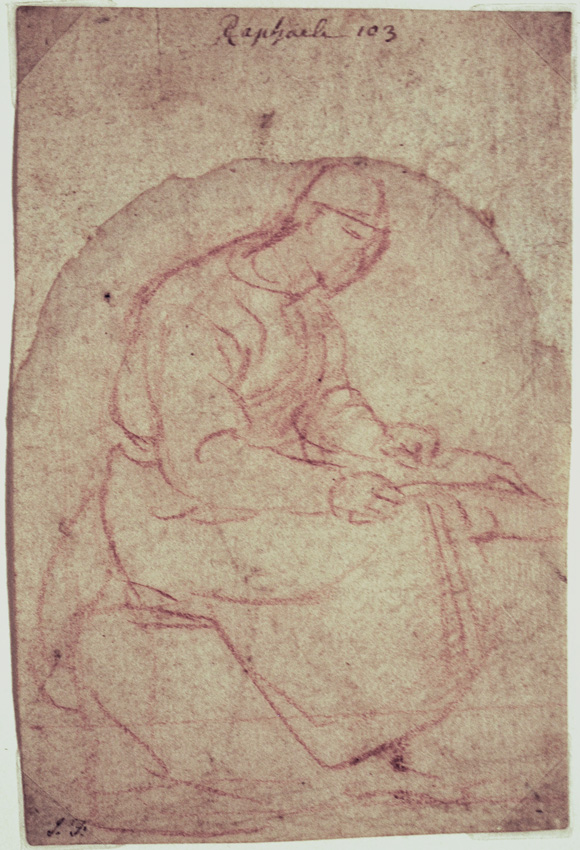 |
|
|
|
Raphael Sanzio (Urbino 1483-1520 Rome), Attributed, Seated figure. Red chalk on old laid paper, c. 1504. Inscribed "Raphael 103" top center; initialed "J. F." in black ink lower left corner. Provenance: letter from Edward G. Hawks, a lawyer from Buffalo NY dated 12/25/1898 to James Dudley Hawks of Detroit MI, describing finding this and two other drawings loosely inserted in a 4-volume set of engravings of Herculaneum (Rome, 1789) with a note on the inside front cover, "Maria Denman–from her affectionate Brother [in-law] and Friend, John Flaxman." Flaxman (1755-1826) was a member of the Royal Academy, a successful sculptor and draftsman; he provided drawings to be engraved by artists (including William Blake) illustrating various texts including the Iliad, the Odyssey, the works of Aeschylus, and the Divine Comedy. Flaxman was in Rome from 1787 to 1794, where he would have had access to drawings by Raphael; Flaxman's own drawings, "unusual at the time for being conceived almost entirely in terms of outline," (Grove Dictionary of Art 11: 162-65; here at 163) might well have made Raphael's drawings of interest to him not just aesthetically but also practically. According to Hawks, he sent this drawing and two others (one of which, The Adoration of the Magi, here attributed to Parmigianino, Hawks calls the "The wise man's offering," misreading the title written on the verso in Flaxman's hand, "The wise men's offering," we have also purchased) to his brother, "hoping they will afford you amusement and profit." Image size: 136x90mm.
On our 27" monitor, this is about lifesize.
|
|
|
|
|
|
The drawing seeems to relate to Raphael's drawings made at Pintoricchio's request (c. 1504) for him to use in his fresco cycle on the life of Pope Pius II in the Duomo in Siena (Vasari, II: 223 [Everyman edition]). In particular, see the 4th fresco, in which the future Pope Pius II is sent by the Emperor Frederick III to Pope Eugenius IV. The fresco shows Aeneas Silvius kneeling in front of the Pope to kiss his slipper; on either side of the Pope there are five seated clerics wearing robes similar to those worn by the figure in our drawing. In an essay published in The Cambridge Companion to Raphael, Bette Talvacchia uses Vasari's Life of Giulio Romano, Raphael's former chief assistant, to suggest what Raphael's workshop practise must have been like: "In assigning his assistants a more substantial role in the labor-intensive procedure of turning out hundreds of preparatory drawings for frescoes, Raphael initiated them into a rigorous working method, which they perpetuated as independent masters. The process devised by Raphael was to execute preliminary, rough sketches, proceed with further consideration of the groupings and individual figures through studies from life (often garzoni in appropriate poses), and then combine the compositional arrangements with the figural studies to form modelli" (p. 178); for an example of using memebers of his workshop as models, see Thomas P. Campbell, Tapestry in the Renaissance: Art and Magnificence (NY: Metropolitan Museum of Art, 2002), figure 21, p. 208; for the process by which the tapestries were designed and realized for the tapestry makers in Brussels, see pp. 189ff . Our drawing seems to be just such a rough sketch (perhaps of one of the workshop assistants), to get the feel of a seated figure seen from the side. For a similar use of chalk to outline a figure, see Joannides 1983 #17, upper left. For the Pinturrichio frescoes, see either The Piccolomini Library in the Cathedral of Siena: The History of Pope Pius II in the Ten Frescoes of Pinturicchio (Siena, 1938) or Pietro Scarrpellini, Pintoricchio all Libreria Piccolomi (Milano: Fratelli Fabbri, 1965), p. 22. For additional seated cardinals in similar garb (though in different postures, see p. 38). For a reproduction of one of Raphael's cartoons, see Rhoda Eitel-Porter, ed. From Leonardo to Pollock: Master Drawings from the Morgan Library (NY: The Pierpont Morgan Library, 2006), pp. 26-27.
|
|
|
|
 |
|
|
|
Giulio Romano (Giulio Pippi; Rome 1499-1546 Mantua), attributed, Scipio rewarding his soldiers. Drawing in pen and brown ink with brown wash. Although he may have begun working on the story of Scipio Africanus as early as 1522-23, at some time prior to 1532 Giulio accepted a commission to design 2 sets of tapestries for François I, King of France on the theme of the Deeds and Triumphs of Scipio. A 22-piece set was made in Brussels between 1532 and 1535 and delivered in parts as they were finished during those years. Another payment was made to Giulio's pupil Francesco Primaticcio, who had arrived at Fontainebleau shortly after 22 March 1532 to travel from France to Flanders, "where he had to carry a modello of the story of Scipio the African, intended for a tapestry that the king was having made in Brussels, and to bring back the cartoon of the said story" (cited in Campbell 343). Campbell's figure 150 shows a preparatory drawing by Giulio that the Musée du Louvre dates c. 1522-1523(?) and that shows The Capture of Carthage in pen and brown ink with brown wash similar to ours. Another of Giulio's drawings for the Acts, The Triumphal Feast of Scipio, is published in Martin Clayton, Raphael and his Circle: Drawings from Windsor Castle (London: Merrell Holberton, 1999), plate 37. Aside from several wormholes lower right corner, center-left bottom, in the thigh of the left-most soldier, in the base of Scipio's throne, and top right and center right, all repaired and all backed with tinted paper, the sheet is in very good condition. For Diana Scultori's engraving of The Clemency of Scipio after Giulio Romano, which may be based upon another of the Acts of Scipio, click here. Image size: 276x184mm. Price: Please call or email for current pricing information.
|
|
|
|
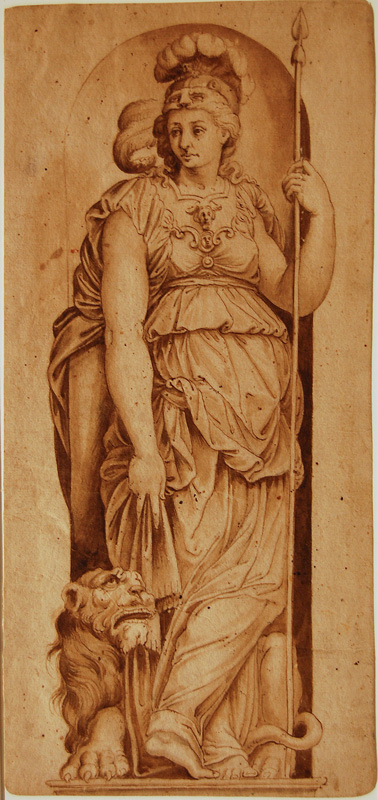 |
|
|
Perino del Vaga (Pietro Buonaccorsi; Florence, 1501-1547 Rome), attributed, Fortitude. Pen and brown ink and wash on heavy laid paper, c. 1545. Perino joined Raphael's workshop around 1516, working on the Vatican Loggia. Vasari notes that Perino's studies (especially his studies of Michelangelo's cartoons in the Sistine Chapel), soon led him to become "the best designer in Rome, with a better understanding of the muscles and the difficulties of nude figures than any, perhaps even among the best masters" Lives, trans. A. B. Hinds, 4 volumes (London: Everyman, 1970), III, 122. It also led Raphael, hearing his praises from Giulio Romano and Gio. Francesco il Fattore, to employ him in the Vatican (Vasari, III, 122). After Raphael's death, Perino worked on several fresco schemes in Rome before being captured in the Sack of Rome and forced to pay a huge ransom that impoverished him and led him to move in 1528 to Genoa in the service of Andrea Doria and then to Pisa c. 1534. About 1537, he returned to Rome and become Pope Paul III's principal painter (Michelangelo's efforts on The Last Judgment for the Sistine Chapel and The Crucifixion of St. Peter for the Pauline Chapel not permitting him time to do anything else for the Pope). Perino executed frescoes of the Four Cardinal Virtues in the Sala Paolina in the Castel Sant'Angelo in Rome. No other studies of Perino's Fortitude are known, although the Met owns his drawing of Prudence in a niche (see J. A. Gere, Drawings by Raphael and his Circle from British and North American Collections (NY: Pierpont Morgan Library, 1987), plate 78. Along with several other drawings, Fortitude and Prudence share a wide, flat big toe; see also Bernice F. Davidson, Mostra di Disegni di Perino del Vaga e della sua cerchia (Florence: Leo S. Olschki, 1966), plates 5, 44, and 45; similar toes may also be found in Perino's drawings reproduced in Gere, plates 67, 71, and 77; for additional examples, click here). For Vasari, in his Life of Perino, the dual tragedies of his life were that "he loved designing better than executing works" (III, 137) and that his poverty forced him to accept so many commissions that he could only do the drawings and was forced to let others paint them: "Having undertaken so much, and being infirm, he could not support his labor, being compelled to work day and night to satisfy the needs of the palace, designing numerous ornaments for the Farnese and other cardinals and lords. he never had an hour's quiet, his mind being constantly occupied, and he was always surrounded by sculptors, stucco-workers, wood-carvers, tailors, joiners, painters, gilders and other artisans [looking for employment]" (Lives, III, 139). Image size: 377x173mm. Price: Please call or email for current pricing information.
|
|
|
|
NEWS FLASH! Perino del Vaga's works were very much in the news last week! From The New York Times: "On 26 January 2011, The Metropolitan Museum of Art set a new world record for a drawing by Perino by paying Please call or email for current pricing information for a drawing for a tapestry of Jupiter and Juno Reclining in an Alcove. The prior auction record for a drawing by Perino was Please call or email for current pricing information. The next day, the Met bought The Holy Family With the Infant St. John the Baptist,” a painting by Perino, for Please call or email for current pricing information million. It had been expected to bring Please call or email for current pricing information to Please call or email for current pricing information. "It was a double sweep,” Keith Christiansen, the Met’s chairman of European paintings, said in a telephone interview. “Perino del Vaga is one of the very great Renaissance draftsmen, but the minute I saw this painting, I nearly keeled over.”
|
|
|
|
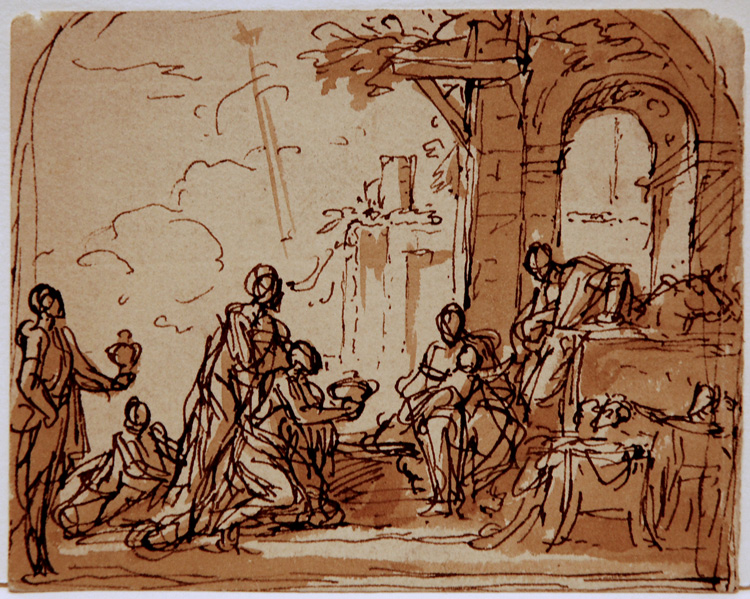 |
|
|
|
Parmigianino, attributed to, The Adoration of the Magi. Pen and brown ink and wash, c. 1526. For a drawing of c. 1526 that exhibits the same look and feel as ours, see plate 37, Christ Healing the Sick, in the new catalogue raisonné of Parmigianino's drawings, by Beguin et al (2000; this is also Popham 5). The drawing is a quick and lively study of the layout of the work in which Parmigianino does not take time to sketch in the features of the individual figures but is more concerned with setting the scene of the appearance of the Magi in a stable surrounded by farm animals and an infant in his mother's arms to which their royalty pays homage. For many additional examples, please see Achin Gnann, Parmigianino: Die Zeichnungen, Band 2: Katalog (Petersberg: Michael Imhof Verlag, 2007); we found Kat. 203, 505, 509 recto, 535, 543, and 661 (the Magi offering gifts to the Virgin and Child) interesting in the ways they show the artist mapping out rough drafts of possible compositions in which he quickly sketches in faces the way he does in our drawing. Provenance: John Flaxman R.A., English, 1755-1826; Flaxman worked in Rome 1787-1794. On the provenance, see the letter below and the reproduction of the verso of the drawing below that, where it is titled "The wise men's offering" in what looks like Flaxman's handwriting. Image size: 88x110mm. Price: Please call or email for current pricing information.
|
|
|
|
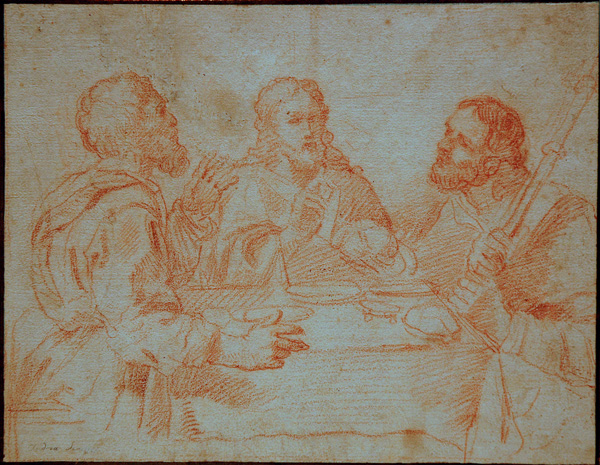 |
|
|
|
Andrea Schiavone (Zara 1510-1563 Rome), The Supper at Emmaus. Red chalk on tan laid paper mounted on laid paper. The drawing illustrates the verses in the Gospel of Luke (Luke 24:13-36) that describe the happenings of Easter Sunday. Attributed to Schiavone in an early italic hand lower left recto and on the verso at the top of the backing sheet, which also gives an old collector's catalogue number. According to the Grove Dictionary of Art, Schiavone (also known as Andrea Meldolla) was born in Zara in Dalmatia and trained either in Zara or in Venice. He worked in fresco, panel painting, and etching (teaching himself to etch by working initially from drawings by Parmigianino). By 1540, he was well enough established in Venice that Vasari commissioned a large battle picture (which he mentions in his Lives). Although initially much influenced by Parmigianino and Central Italian Mannerism, "he was also a strikingly daring exponent of Venetian painterly techniques," and ultimately combined both in his works, influencing Titian, Tintoretto, and Bassano among others. His works "shocked some contemporaries and stimulated others." By the 1550s, he had achieved a new synthesis of Raphael and Titian's compositional elements with his own interest in atmosphere, effecting a "fusion of form with a dense atmosphere in a pictorial fabric whose elements tend to lose their separate indenties" (Francis E, Richardson, in the Encyclopedia of Italian Renaissance & Mannerist Art, 2: pp. 1502-04 at 1503). Image size: 201x264mm Price: Please call or email for current pricing information.
For another drawing by Schiavone, please click here.
|
|
|
|
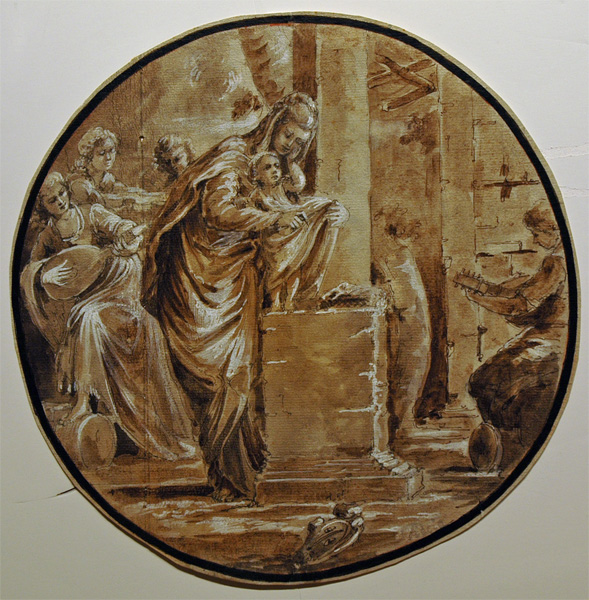 |
|
|
|
Our drawing is a variant of a drawing in the Louvre by Paolo Cagliari called Veronese (c. 1528-1588), titled "Pittura Quarta," and titled variously Virgin and Child with Musical Angels in the Wilderness (Richard Cocke, Veronese Drawings. A catalogue raisonné [London: Sotheby Publications, 1984], n. 19, p. 76) or The Madonna as a Seamstress (W. R. Rearick, The Art of Paolo Veronese 1528-1588 (Washington DC: National Gallery of Art, 1988). Brown wash base with pen and brown ink and heightening in white body color. Our drawing is on cream laid paper with a watermark close to Briquet 7112 (Salerno 1570) and 7113 (Ferrara 1570) and a worn collector's mark on verso. For more on Veronese, click here.
The Louvre's variant, "Pittura Quarta," depicts the Virgin and Child surrounded by six angels in a rectangular format. The Virgin holds what Cocke describes as the same "strange implement (a Pair of tongs?)" while Jesus reaches up to caress her face. On the left side, three musical angels in similar positions in a similar arrangement are serenading them; on the right, three more angels play for her, one of whom, seated playing a lute is close to ours, the only one on the right side of our drawing. In the background are the ruins of a building (perhaps the manger). Cocke dates the "splendid series of finished chiaroscuro drawings catalogued together (numbers 17-42) as independent works produced in the 1550s and early 1560s" [p. 21]). Rearick dates it 1583-84 and reproduces it as the frontispiece of The Art of Paolo Veronese 1528-1588 in a full-page illustration and discusses again on pages 164-65 with a smaller illustration. Our drawing is circular, the Louvre's is rectangular. Both are beautiful and well-executed drawings, ours, perhaps a presentation drawing, seems more brilliant, finished and assured. According to Cocke (p. 77, note 7), the Louvre's Veronese remained in Veronese's studio during the artist's lifetime: "That it remained in the studio may be confirmed by the painting in the collection of Antonio Zecchini in Pescara, which measured about the same size as the drawing and was, to judge from the engraving by Diogini Valesi, a studio derivation from the drawing." Our Veronese shows precisely the characteristics that Cock praises: "independent works in preparatory drawings and executed with a brilliance and fluidity in the white heightening that was copied but never equalled." Rearick identifies the "strange implement" as a pair of shears, with which the Virgin is trimming Jesus' garment. This makes sense of the little basket sitting next to Jesus' feet as her sewing basket. His arguments for the later date can be found on p. 165. Rearick's later date finds at least some support in Annalisa Scarpi's remarks on a drawing in pen and brown ink with white lead heightening that Veronese prepared in connection with his Triumph of Venice for the ceiling of the Sala del Maggior Consiglio above the Doge's throne commissioned 1579 and completed by 1582 (see Giandomenico Romanelli et al, Veronese: Gods, Heroes and Allegories [Milan: Skira, 2004], p. 140; see also p. 142, where Scarpi dates another of the chiaroscuro drawings, The Triumph of Fame over Evil to the 1580s).
Cocke's comments on these chiaroscuro drawings are useful: "The independent chiaroscuro drawings were among the most admired of Veronese's drawings, being the only ones mentioned by his first biographer Ridolfi in 1648. Ridolfi's enthusiasm is understandable, for they were planned as independent works in preparatory drawings and executed with a brilliance and fluidity in the white heightening that was copied but never equaled. Veronese here turned to an older tradition of Venetian drawing with a sense of invention in conventional subjects, both religious and allegorical and in unusual variations on well-established themes (p. 71). If Rearick is correct in his dating and the date of ours is close to the year in which the paper was manufactured, ours is either a variant of another drawing of the scene not yet published or it is the original version of the Louvre's drawing.
One of Veronese's small ink drawings sold at auction at Christie's London on Dec. 5, 2006 for £180,000 (then Please call or email for current pricing information). We offer ours for a bit less than that price. Image size: 285mm diameter. Price: Please call or email for current pricing information.
After long blocks of text, there will be huge open spaces. Please persevere: images and texts will follow.
|
|
|
|
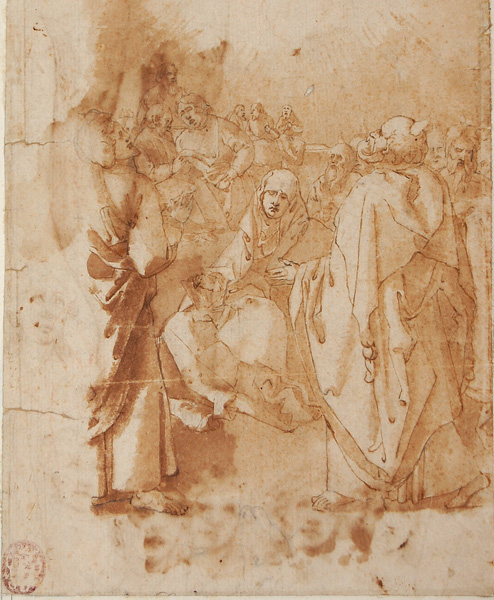 |
|
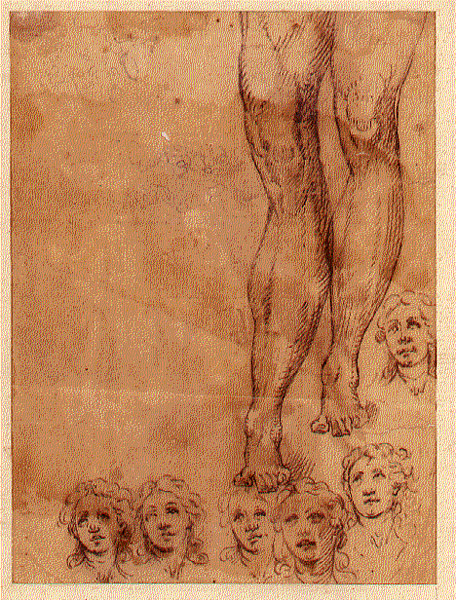 |
|
|
|
Paolo Veronese, attributed, Pentecost. Pen and brown ink and wash on cream laid paper, c. 1545-55?. Old collector's mark lower left. On the verso are 6 studies of heads looking upwards and a study of feet and legs, possibly a study for a crucifixion. The heads show through on the left side and the bottom of this sheet. If one compares this drawing with Durer's Pentecost in the Small Woodcut Passion, it is clear that Veronese was working with it close at hand. Image size: 215x165mm. Price: Please call or email for current pricing information.
|
|
VERSO: Paolo Veronese, attributed, Studies for a Crucifixion? Pen and brown ink and wash on cream laid paper, c. 1545-55?. Old collector's mark verso lower left. On the verso is a study of Durer's Pentecost from the Small Woodcut Passion showing the Virgin and the Apostles receiving the Holy Spirit on Pentecost. Image size: 215x165mm.
|
|
|
|
|
In his introduction to W. R. Rearick, The Art of Paolo Veronese 1528-1588 (Washington DC: National Gallery of Art, 1988), Teresio Pignatti observes that one of the ways in which Veronese differs from his contemporaries is "his exceptional virtuosity in drawing," which was based "not only on direct acquaintance with the paintings to be seen in Mantua and Parma, but also on his familiarity with drawings and engravings by or after Parmigianino and his Venetian followers such as Schiavone" (p. 6). According to Pignatti, early critics of Veronese, starting with Vasari, stressed Veronese's graphic skill as "an essential aspect of an artist they viewed almost as repudiating the reigning principle in Venice, color." Pignatti notes that in 1556 Francisco Sansovino, the first critic to describe the paintings in the Sala del Consiglio dei Dieci in the Palazzo Ducale, affirmed that " 'Paolo is beginning to make himself known as something rare in his profession' and that his work proves him 'truly possessed of disegno [design, drawing] and delicacy.' " Pignatti also reminds us that Ridolfi's mid-17th century study of Veronese stresses that Veronese "used to train his hand by copying Durer's engravings and prints, and perhaps as well certain drawings by Parmigianino that he found in an album owned by the Muselli family in Verona" (p. 6). We may observe this in the drawing after Durer's Pentecost from his Small Woodcut Passion above left.
For aditional works by Veronese, please click here.
|
|
|
|
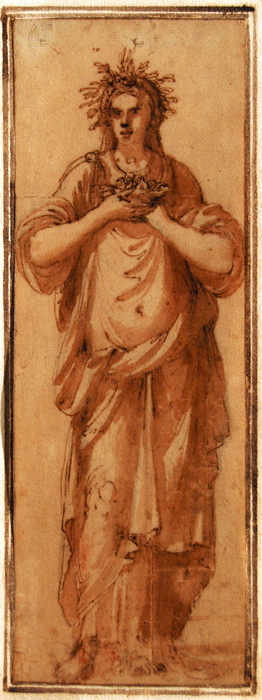 |
|
|
Federico Zuccaro (Italian, 1540-1609), Study of an mythological figure (Ceres). Pen and brown ink and wash on cream laid paper mounted on laid paper, c. 1561-63. Our drawing was originally attributed to Bernardino India (1528-1598) and Lionello Spada (1576-622), however, Suzanne Folds McCullagh (Chicago Art Institute) and L. M. Giles rejected this attribution in a conference with a previous owner on 15 October 1996. McCullagh suggested either Taddeo or Federico Zuccaro and dated it c. 1570. Further research has suggested that the drawing is related to Federico's Frieze with scenes from the Lives of Moses and Aaron in the Palazzo del Belvedere, Appartamento do Ritiro of Pope Pius IV. c. 1561-63. (See Carlo Pietrangeli, Paintings in the Vatican [Boston: Bulfinch Press, 1996], page 412, n. 391, 2nd stucco figure from the left). Federico had done a number of allegories (see e.g. his Allegory of Sloth in the Fogg Art Museum at Harvard [Mundy n. 43[ and some of the cycle of drawings in his Life of Taddeo, esp. n. 1, 3-4, 6, 11, and 15-16), and the drawing style supports the attribution. Image size: 272x97mm. Price: Please call or email for current pricing information.
For aditional works by Federico Zuccaro, please click here.
|
|
|
|
|
|
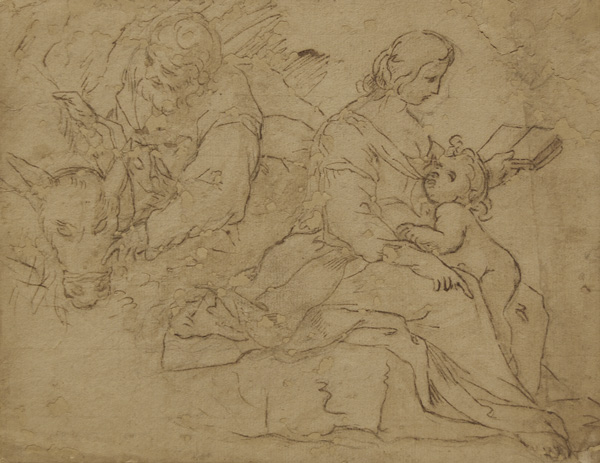 |
|
|
|
Ludovico Carracci (Bologna, 1555-1619), Rest on the Flight into Egypt, attributed. Pen and brown ink drawing on cream laid paper mounted on laid paper; a number of small holes in the paper have been made less unsightly by coloring the backing sheet. (It really isn't as bad to the eye as the photo makes it seem). With his cousins, Annibale and Agostino, and their pupils, dominated the Bolognese art scene for much of the early-mid 17th century. There is a pencil attribution to Ludovico Carracci on the verso. Image size: 184x235mm. Price: Please call or email for current pricing information.
|
|
|
|
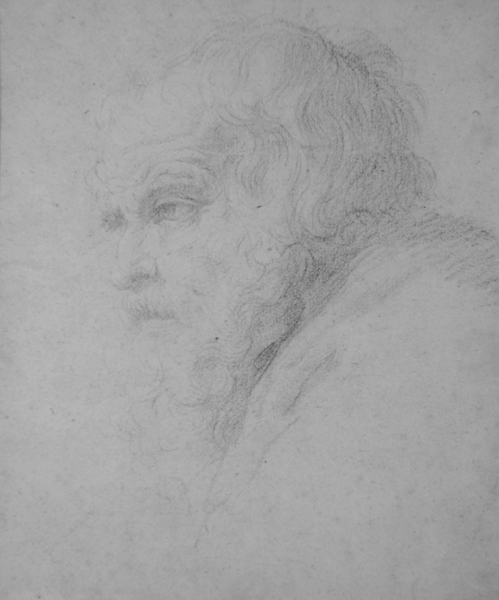 |
|
|
|
Domenichino (Domenico Zampieri, 1581-1641), Head of an old man looking to the left. Black chalk stumped and whitened with white chalk on heavy grayish-brown laid paper. On the verso is a fragment of another drawing showing a dragon attacking on horse and rider) while on the right a woman watches (see below), probably a study for a St. George battling the dragon. This study presents a type common in Domenichino's works: an old man, with a long, curly beard, an aquiline nose, and a very high forehead. See Spears, vol. 2, plates 3 (St. Jerome, 1602), 10 (Joseph of Arimathea, 1602), 34-35 (St. Joseph, 1604-06), 46 (St. Jerome, 1606-08), 73 & 76 (St. Niles, 1608-1610), 143 (St. Jerome, 1614), and 197 (1618-19). The study for the Last Communion of St. Jerome (pl. 143) is perhaps the closest to ours in overall feel, but the old man is more an ideal type than a study of a specific model. Image size: 392x248mm. Price: Please call or email for current pricing information.
For more drawings by Domenichino, please click here
|
|
|
|
|
|
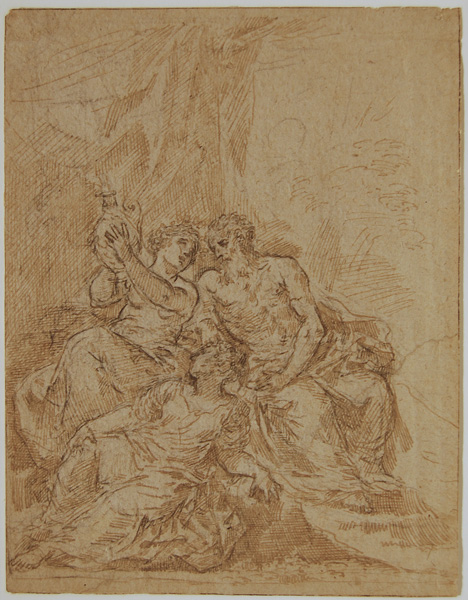 |
|
|
|
Bolognese School (early-mid 17th century), Lot and his Daughters. Pen and brown ink on cream laid paper mounted on laid paper. At Abraham's urging, God selected Lot (Abraham's nephew) and his family as the only just people in Sodom to be saved. Although he warned them not to look back at the destruction of Sodom as they fled, Lot's wife did and was turned into a pillar of salt. Later that night, Lot's daughters, fearing that they were the only ones left alive in the world, got Lot drunk and then slept with him in order to repopulate the earth. This nicely-ironic story, like many others, is a reminder that one ought not to trust to his or her own virtue but to God's mercy. It became a more popular subject after the Reformation and the Counter-Reformation. Image size: 236x183mm. Price: Please call or email for current pricing information.
|
|
|
|
|
|
 |
|
|
|
Simoni Cantarini (Pesaro, 1612-1648), John the Baptist in the Wilderness. Red chalk with white chalk heightening on light tan laid paper. On the verso is a study of an angel above a reclining body. Image size: 230x227mm. Price: Please call or email for current pricing information.
For more drawings by Cantarini, please click here
|
|
|
|
 |
|
|
|
Matteo Rosselli (Italian, 1578-1651), attributed, Woman and child asleep in a landscape. Red chalk on cream laid paper, c. 1610. Image size: 285x443mm. Price: Please call or email for current pricing information.
|
|
|
|
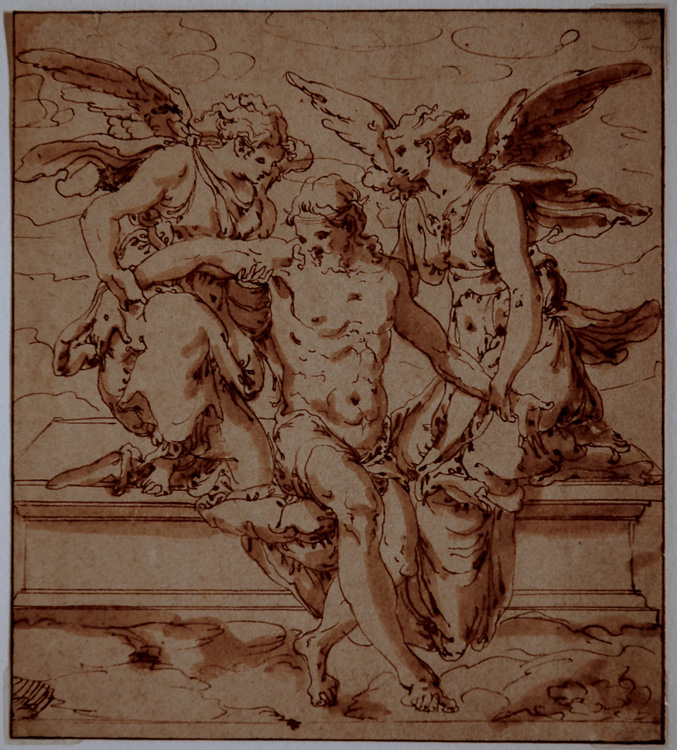 |
|
|
Pier Francesco Mazzuccelli, il Morazzone (Morazzone, 1573-1626) attributed, Christ on a tomb supported by two angels. Pen and brown ink and wash on cream laid paper. In this effective and moving drawing, the two angels present the dead body of the crucified Christ directly to the viewer. It is incumbent on the viewer not to give in to a Good Friday despair but instead to have faith that the promised Easter Resurrection will occur. The painter was taken to Rome by his father, a master mason, in 1592. According to Alberto Bertoni's entry in the Grove Dictionary of Art (22: 81-83), "Borsieri (1619) claimed that he was taught there principally by the Sienese painter Ventura Salimbeni, whereas Baglione (1642) stated that he frequented the various academies of Rome" (81). Bertoni suggests that "it is likely that he also gained experience in the workshop of the Cavaliere d'Arpino" (81). He was apparently able to attract attention fairly quickly, working in several important churches in Rome. After training in Rome for about 5 years, Il Morazzone returned to Lombardy, where he painted frescoes in churches and palaces in Varese, Milan, Como, Varollo, Turin, and Mantua. According to Bertoni, "With Cerano, Giulio Cesare Procaccini, and Tanzio da Varallo, he was one of the principal Lombard painters of the early 17th century. Like many of his contemporaries, he was strongly affected by the piety and mysticism of the teaching of St. Carlo Borromeo, yet his work is distinguished from theirs by a greater classicism, owing to his training in Rome" (81) Bertoni also praises him as "an original draughtsman" and notes that the major collections of his drawings are in Milan and Florence (in the Uffizi). For a comparable drawing, see Martin Royalton-Kisch, Hugo Chapman, and Stephen Coppel, Old Master Drawings from the Malcolm Collection (London: British Museum, 1996), p. 91. Image size: 164x145mm. Price: SOLD.
|
|
|
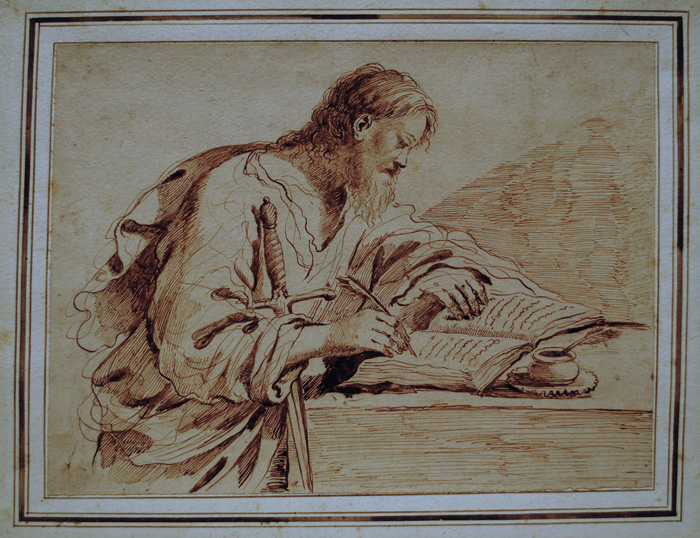 |
|
|
|
Guercino (Giovanni Francesco Barbieri, 1591-1666), attributed, St. Paul. Brown chalk drawing on laid paper with no watermark laid down upon a heavy sheet of laid paper with an irregularly-drawn decorated border, perhaps for mounting in an album. St. Paul sits at a desk, writing one of his epistles, the sword of his martyrdom leaning against the table upon which he works; an inkpot sits by his book within easy reach. The same sword is visible in Guercino's large 1644 oil painting of St. Paul in the Cuppini Collection in Verona (see David M. Stone, Guercino: cataloge completo die dipinti [Cantini 1991], n. 188 on p. 203). The elaborately-feathered quill pen that St. Paul uses seems to be, if not the same then at least very similar, although the treatment of the saint is different (in the painting he faces to the left at a 45 degree angle and is much more heavily bearded. Image size: 208x279mm. Price: Please call or email for current pricing information.
For more drawings by Guercino, please click here.
|
|
|
|
 |
|
Baldassare Franceschini called Il Volterrano (Italian, 1611-1669), Aeolus supported by the winds. Black chalk on cream laid paper (watermark: 6-pointed star with a cross and the letter N in a circle–Briquet 6089 1587-88 and after). Il Volterrano was the son of a sculptor and a prodigy. He studied with Matteo Rosselli (see above) in Florence and was then sent to work with painters in Parma and Bologna. He worked in both fresco and oil for the Medici. Aeolus, the subject of our drawing, was the god of the winds in classical mythology. Here he rests upon a cloud accompanied by two of the Winds and observes the goings on beneath his throne. For other drawings by Il Volterrano, see Catalogue of An Important Group of Drawings by Baldassare Franceschini, called Il Volterrano (London: Sotheby's, 1980). Image size: 143x148mm. Price: Please call or email for current pricing information.
|
|
|
|
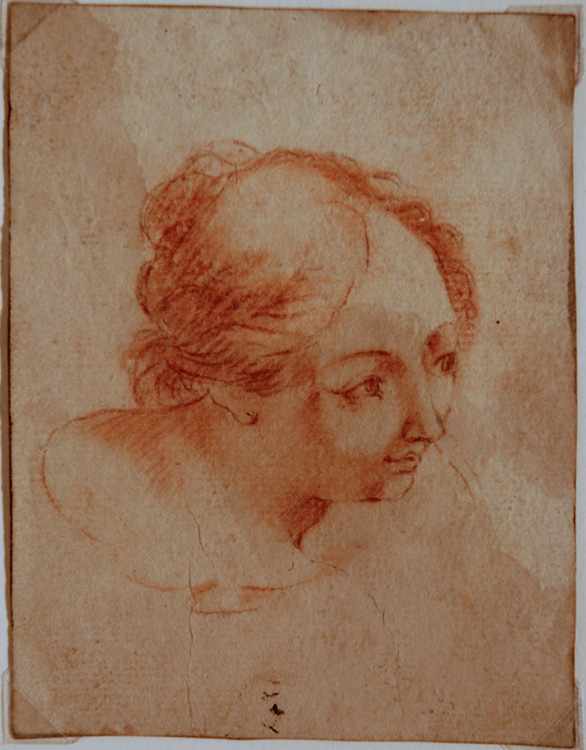 |
|
|
|
School of the Carracci, 17th-century, Study of a young woman turned to the left II. Red chalk drawing on heavy cream laid paper with no watermark. A study of the head of a beautiful young woman. The uneven trimming of the paper suggests that it might once have been a part of a larger composition and may signal that this collection was put together for the assistants in the workshop of an artist successful enough that he needed assistants. Image size: 113x86 mm. Price: Please call or email for current pricing information.
This is part of a group of drawings that had all been a part of the same collection and had all been mounted with the same tape. For the others, please click here. The group contained 9 in red chalk: three cherubs or infants, three St. Sebastians, two women, and one old man. Although it is possible they are all by the same artist, it may say more about the taste of the collector: all are about the same size and they are united at least by the taste of the collector and perhaps by the artist as well.
|
|
|
|
|
|
 |
|
|
School of the Carracci, 17th-century, Study of a Cherub. Red chalk drawing on heavy cream laid paper with no watermark. A study of the head and shoulders of a Cherub (it strikes us as too adult to be a little boy). Although these figures do not seem capable of any action, we might remember Macbeth's musings (I.vii.21-25) and the consequences of murdering King Duncan:
And pity, like a naked new-born babe,
Striding the blast, or heaven's cherubin, horsed
Upon the sightless couriers of the air,
Shall blow the horrid deed in every eye
That tears shall drown the wind.
The uneven trimming of the paper suggests that it might once have been a part of a larger composition and may signal that this collection was put together for the assistants in the workshop of an artist successful enough that he needed assistants. Image size: 120x80 mm. Price: Please call or email for current pricing information.
|
|
|
|
|
|
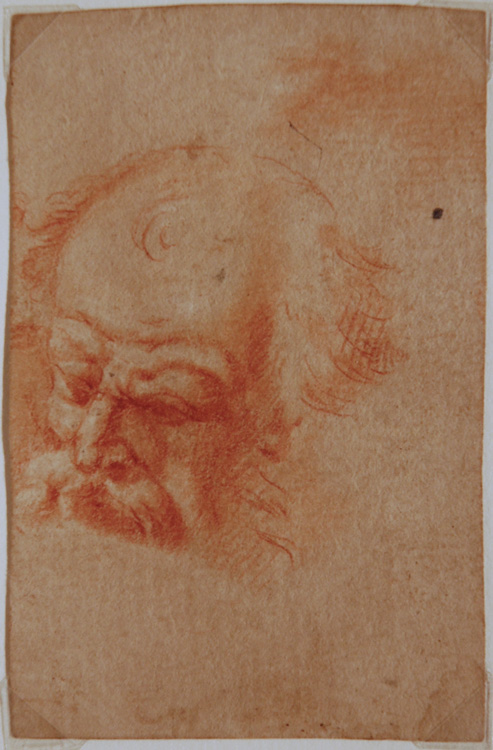 |
|
|
|
School of the Carracci, 17th-century, Study of an old man turned to the right. Red chalk drawing on heavy cream laid paper with no watermark. A beautiful study of the head of an old man, with just a few hairs left in the center of his head; like these reminders of his vanished hair, the uneven trimming of the paper suggests that it might once have been a part of a larger composition and may signal that this collection was put together for the assistants in the workshop of an artist successful enough that he needed assistants. Image size: 108x74 mm. Price: Please call or email for current pricing information.
On my 27-inch monitor, this is about life-size.
|
|
|
|
|
|
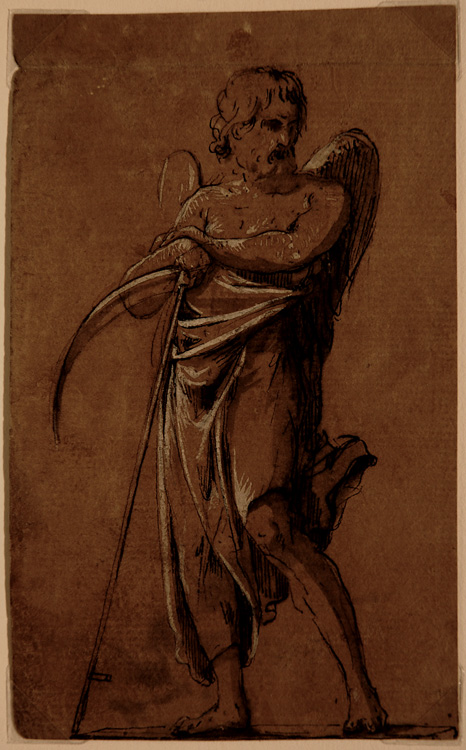 |
|
|
|
Italian School, early 17th-century. Time with his scythe. Pen and black ink and white bodycolor on brown laid paper, For a late 16th-century description of Time as the destroyer of all things beautiful, like the lilies of the field, see Edmund Spenser's The Faerie Queene, Book III, Canto vi, Stanza 39:
Great enimy to it, and to all the rest,
That in the Gardin of Adonis springs,
Is wicked Time, who with his scyth addrest,
Does mow the flowring herbes and goodly things,
And all their glory to the ground downe flings,
Where they doe wither, and are fowly mard:
He flyes about, and with his flaggy wings
Beates downe both leaues and buds without regard,
Ne euer pittie may relent his malice hard.
Image size: 157x96 mm. Price: Please call or email for current pricing information.
|
|
|
|
|
|
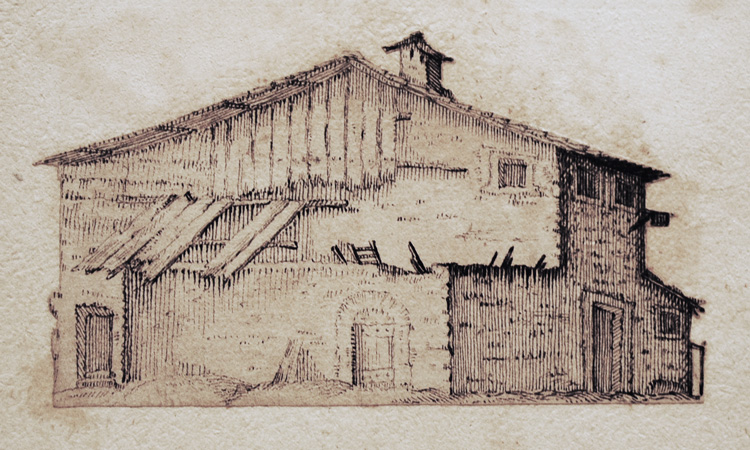 |
|
|
|
Ercole Bazzicaluva (Pisa, 1610-after 1641, Florence), A Florentine Farmhouse. Original pen and brown ink drawing, after 1630. Drawing on laid paper glued to a larger sheet of laid paper. Our drawings all came from one collection and may have been trimmed from larger compositions to form a library of poses for the workshop of some unknown artist, perhaps Bazzicaluva or one of his pupils. Image size: 52x92mm. Price: Please call or email for current pricing information.
The drawing is shown larger than life; for 26 more drawings by Bazzicaluva, click here.
|
|
|
|
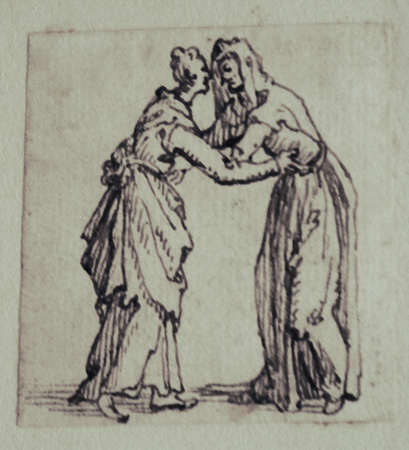 |
|
|
|
Ercole Bazzicaluva (Pisa, 1610-after 1641, Florence), The Visitation: Mary and Elizabeth each feel the other's enwombed child and believe. Original pen and brown ink drawing, after 1630. Drawing on laid paper glued to a larger sheet of laid paper. Our drawings all came from one collection and may have been trimmed from larger compositions to form a library of poses for the workshop of some unknown artist, perhaps Bazzicaluva or one of his pupils. Image size: 50x44mm. Price: Please call or email for current pricing information.
The drawing is shown larger than life.
|
|
|
|
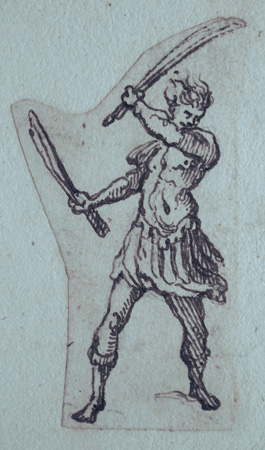 |
|
|
|
Ercole Bazzicaluva (Pisa, 1610-after 1641, Florence), Antique warrior with two swords. Original pen and brown ink drawing, after 1630. Drawing on laid paper glued to a larger sheet of laid paper. Our drawings all came from one collection and may have been trimmed from larger compositions to form a library of poses for the workshop of some unknown artist, perhaps Bazzicaluva or one of his pupils. Image size: 63x34mm. Price: Please call or email for current pricing information.
The drawing is shown larger than life.
|
|
|
|
Spaightwood Galleries, Inc.
To purchase, call us at 1-800-809-3343 (1-508-529-2511 in Upton MA & vicinity) or send an email to spaightwood@gmail.com
We accept AmericanExpress, DiscoverCard, MasterCard, and Visa.
We also accept wire transfers and paypal.
For directions and visiting information, please call. We are, of course, always available over the web and by telephone (see above for contact information). Click the following for links to past shows and artists. For a visual tour of the gallery, please click here. For information about Andy Weiner and Sonja Hansard-Weiner, please click here. For a list of special offers currently available, see Specials.
All works are sold with an unconditional guarantee of authenticity (as described in our website listing).
Copyright 2004-2017, Spaightwood Galleries, Inc.
Go back to the top of this page.
Visiting hours: Saturday 10:00 am to 5:00 pm and Sunday noon to 6:00 pm and other times by arrangement.
Please call to confirm your visit. Browsers and guests are welcome.
|
|
|
|
|
|
|
|
|
|
|
|
|
|
|
|
|
|
|
|
|
|
|
|
|
|
|
|
|
|
|
|
|
|
|
|
|
|
|
|
|
|
|
|
|
|
|
|
|
|
|
|
|
|
|
|
|
|
|
|
|
|
|
|
|
|
|
|
|
|
|
|
|
|
|
|
|
|
|
|
|
|
|























